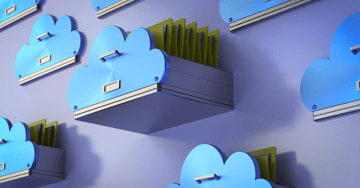Choosing the Right Encrypted File-Sharing System for Your RIA
Share this
As tax season approaches, you may find yourself scrambling for the best and safest way to exchange critical documents with your clients securely. With so many choices and words like “256-bit SSL encryption” and “ciphers” swirling around, paralysis from overanalysis can take hold, leaving your clients wondering just how to send you the information you need and you wondering why you have so many systems storing so many different client files.
What is an Encrypted File Sharing System?
Let’s start by shedding light on this complex and often misunderstood world of digital client file exchange. For most of us, gone are the days of clients coming in with a yellow envelope stuffed to the brim with tax documents. In our new and evolving world, advisors have clients from all over the country and take meetings from locations all over the world. What hasn’t changed is the important data collection that advisors garner from the document-sharing that once occurred via yellow envelope.
Today, advisors use encrypted file-sharing practices that protect sensitive data during file transfers and storage. Encrypted file-sharing features can sometimes be a feature of a firm’s document management system but do not have to be. Many advisors utilize document vaults that are housed in a client portal within their financial planning system, portfolio reporting software, or other ancillary planning tools. In either case, once the client uploads the file, it is typically transferred out of the shared location and into the client folder within the firm’s document management system.
How to Choose a File-Sharing System?
Here’s where things get a little complicated. We know we need a way to exchange digital files securely, but the truth is many different systems can be used to manage your firm’s documents, and many of them offer sharing capabilities where you and your clients can exchange documents securely. So just how do you decipher the best and safest choice for you and your clients? (Hint: this is not a one-size-fits-all situation.)
It starts with choosing the right set of criteria, and that starts with knowing where you are in your entrepreneurial journey. If you are an established firm and you’re reassessing your tech stack, then we recommend keeping. things. simple. This will likely take the form of reassessing your tech stack and taking the opportunity to cut out redundancies. Specifically, rather than adding yet another system your client has to log into and manage, we recommend that you attempt to find a document exchange feature within an existing software system you intend to keep and use more effectively. Bonus points if you find an existing system you already intend the client log in to for another reason!
If, however, you find yourself in a place where you either don’t use a system that meets the recommended criteria (discussed below) or you are at the beginning of your RIA journey and are in the process of choosing a tech stack, we recommend an important rule of thumb: Try to choose systems that have a dual purpose and, above all, LIMIT the number of systems your clients need to access when working with you.
Here’s what we mean. Both RightCapital and eMoney have client portals that include a vault that allows clients to share files. This means that the client can, with one login, access their net worth, financial goals and associated progress, to-do list, and upload and download important documents securely. If you have an investment management-centered model, consider the client portal in Orion Advisor Tech or your preferred portfolio reporting software. Here, clients can both see their performance reports and use the Document Vault to find statements and exchange files.
If you’re confident you will use the client portals in any of these client-facing systems, we don’t recommend creating a separate system for client file exchange without carefully considering the tradeoffs of any additional software costs and additional systems for you and your clients to juggle.
If you don’t intend to use a client portal, Box, Dropbox, Google Drive, or Microsoft OneDrive can offer a great way to reduce systems by acting as your document management system, as well as your secure file-sharing system. In both cases, clients can upload and download files to a shared folder in a system they likely are already familiar with. Be sure to consider permissions settings carefully within each system as you share folders and files with clients.
Features You Should Look for in a File Sharing System
Once you establish a list of potential existing systems with document exchange features, it’s time to check for security protocols that follow best practices when it comes to document exchange.
Recommended Best Practices for Exchanging Files Securely:
- Any system worth its salt will have encryption capabilities for file transfers and file storage (often called encryption in-transit and encryption at-rest.)
- For files this sensitive, you should choose a system that will also require clients to either create a password (which would be set up during onboarding) or use a verification system that will send them a unique code during each login.
- Advisors should follow best practices around data security by using unique auto-generate passwords for each system within their tech stack, automatic password resets every 90 days, and utilizing two-factor authentication options when available.
Depending on your clients, you may need to consider additional security protections and features:
- Some advisors prefer to exchange highly sensitive documents like tax returns using a feature that attaches a unique password to a particular file. If you use this mechanism, be sure to share the password carefully in a client vault, during a meeting, phone call, or using encrypted email functions.
- At times, it can be useful to track the viewing history on a document to see when the client last opened the document.
- Another great method to consolidate system choices is to choose systems that integrate well with one another. For instance, Sharefile integrates directly with Wealthbox and PreciseFP, allowing you to create more automation in your file exchange process. Knowing how your systems integrate maximizes efficiency.
RightCapital
Data Security Information
Client Portal: ✅
Document Vault: ✅
Encryption for file transfers: ✅
Encryption for storage of files: ✅
Forced 2FA for External Users: ❌
Password Protected File Sharing: ❌
Track Viewing History: ✅
Watermarking: ❌
Pros: This is a multifunction system that allows clients to see their financial plan, net worth, tasks, and exchange documents. It's just one more way to get clients to see their financial plans regularly.
Cons: Since this is a newer system, you'll need to invest in a "How-to Video Guide" that shows clients the system and where to find the Vault. This system requires a password and setup, which can be an issue for some clients.
eMoney
Data Security Information
Client Portal: ✅
Document Vault: ✅
Encryption for file transfers: ✅
Encryption for storage of files: ✅
Forced 2FA for External Users: ❌
Password Protected File Sharing: ✅
Track Viewing History: ✅
Watermarking: ✅
Pros: This is a multifunction system that allows clients to see their financial plan, net worth, tasks, and exchange documents. It's just one more way to get clients to see their financial plans regularly.
Cons: Since this is a newer system, you'll need to invest in a "How-to Video Guide" that shows clients the system and where to find the Vault. This system requires a password and setup, which can be an issue for some clients.
Orion Advisor Solutions
Data Security Information
Client Portal: ✅
Document Vault: ✅
Encryption for file transfers: ✅
Encryption for storage of files: ✅
Forced 2FA for External Users: ❌
Password Protected File Sharing: ❌
Track Viewing History: ✅
Watermarking: ✅
Pros: This is a multifunction system that allows clients to see their performance reports, invoices, and statements, in addition to being able to exchange documents securely.
Cons: Since this is a newer system, you'll need to invest in a "How-to Video Guide" that shows clients the system and where to find the Vault. This system requires a password and setup, which can be an issue for some clients.
Sharefile
Data Security Information
Client Portal: ✅
Document Vault: ✅
Encryption for file transfers: ✅
Encryption for storage of files: ✅
Forced 2FA for External Users: ❌
Password Protected File Sharing: ✅
Track Viewing History: ✅
Watermarking: ✅
Pros: Advisors love the notifications they receive when files are uploaded from clients. Sharefile also integrates well with many systems, which allows for more automation.
Cons: Sharefile can be slow to upload and download files, and can at times freeze and force a system restart. You cannot edit files within Sharefile. There can sometimes be syncing delays and issues.
LaserFiche
Data Security Information
Client Portal: ✅
Document Vault: ✅
Encryption for file transfers: ✅
Encryption for storage of files: ✅
Forced 2FA for External Users: ✅
Password Protected File Sharing: ✅
Track Viewing History: ✅
Watermarking: ✅
Pros: Laserfiche was designed to deliver content to decision-makers in real-time, so its workflows are highlight customizable.
Cons: This software is being used less and less, and advisors are reporting less satisfaction with the tool as a Document Management System.
Encrypto
Data Security Information
Client Portal: ❌
Document Vault: ❌
Encryption for file transfers: ✅
Encryption for storage of files: ✅
Forced 2FA for External Users: ✅
Password Protected File Sharing: ✅
Track Viewing History: ✅
Watermarking: ❌
Pros: Encrypto lets you encrypt files before sending them. It can be attached to both Google and Microsoft. It allows the user to drop a file into Encrypto, set a password, and send it with the added security of a password attached to the file.
Cons: There is no 2FA available on the passwords or to login to Encrypto. There is also no secure deletion for plaintext originals.
Dropbox
Data Security Information
Client Portal: ❌
Document Vault: ✅
Encryption for file transfers: ✅
Encryption for storage of files: ✅
Forced 2FA for External Users: ✅
Password Protected File Sharing: ✅
Track Viewing History: ✅
Watermarking: ✅
Pros: Dropbox allows you to easily create links to allow clients to share and upload files. Users can create templated storage file tree systems that can be replicated across all clients. Brand recognition among other professionals allows stronger collaboration and easier file sharing.
Cons: Slow processing times for uploading files and moving files around. There can be issues with uploading files originating from Google Sheets.
Box
Data Security Information
Client Portal: ❌
Document Vault: ✅
Encryption for file transfers: ✅
Encryption for storage of files: ✅
Forced 2FA for External Users: ✅
Password Protected File Sharing: ✅
Track Viewing History: ✅
Watermarking: ✅
Pros: This cloud-based file-sharing system has almost all the bells and whistles from customized branding and archiving to the ability to share large files securely. A client can even upload a document securely through email.
Cons: There can be issues with uploading files originating from Google Sheets.
Microsoft OneDrive
Data Security Information
Client Portal: ❌
Document Vault: ✅
Encryption for file transfers: ✅
Encryption for storage of files: ✅
Forced 2FA for External Users: ✅
Password Protected File Sharing: ✅
Track Viewing History: ✅
Watermarking: ❌
Pros: Clients will easily understand how to upload and download documents into a shared folder. If you use this as your document management system, the process of transferring the files to a client folder will be easy.
Cons: There can be issues with uploading files originating from Google Sheets. Microsoft 365 Online can sometimes produce formatting issues when you try to download documents.
Google Drive
Data Security Information
Client Portal: ❌
Document Vault: ✅
Encryption for file transfers: ✅
Encryption for storage of files: ✅
Forced 2FA for External Users: ❌
Password Protected File Sharing: ❌
Track Viewing History: ✅
Watermarking: ❌
Pros: Clients will easily understand how to upload and download documents into a shared folder. If you use this as your document management system, the process of transferring the files to a client folder will be easy.
Cons: There can be issues with uploading files that have originated in Excel and some graphic features in Word.
Ready, Set, Go!
Now that you have found a dual-purpose system that meets your feature and security requirements, it’s time to set things in motion. First, we recommend setting up your client portals or shared folders consistently across all clients. This is a great opportunity to invest a few hours in learning your system and how to maximize it in your practice. Now, it’s time to introduce the process of document sharing to your clients in a way that sets them up for success. Here are some hot tips from XYPN Ops:
- Anytime you’re inviting a client into a new system, be sure to create and send an instructional video on how to log in and navigate through the system.
- When you are inviting clients to share files, include an instructional video or written instructions on how to upload and download files in the system.
- It’s important to name the folder carefully to avoid sharing wrong information with a client. Make it obvious that this is a shared location by choosing a naming convention like “Shared.”
A Word of Caution
Just like all things, there are tradeoffs that you and your clients must face by investing in data security. With password-protected systems and 2FA enabled when possible, it’s only a matter of time before a client asks for help with password issues or setup, and that can take valuable time away from other client work.
You can preempt the struggles by doing a few things to support your clients through this process of entering the brave new world of truly secure data exchange. Consider creating an instructional video on how to reset your password or troubleshoot an upload issue. If you work with clients who are less tech-savvy and may need extra support, consider creating a 15-minute tech support event in your scheduling system that your clients can use to book a time with you or your team to receive support during the initial transition to a new system. If you work with folks who consistently have trouble with new systems, consider using software they will likely already be familiar with.
House these videos in an easy-to-reference location like your current client page within your website. These steps will reduce the time you spend investing in password issues and empower your clients to log in to their systems and see the full value of your service.
Encrypted file transfer options aren’t exactly the most exciting choice you will make for your firm, but it is an essential component of how you will collect important data and conduct business on a day-to-day basis with your clients. No wonder a November 2023 Kitces Report showed choosing a document management system ranked 3rd out of 27 in terms of importance by surveyed advisors (pg 128.) In other words, it may not be glamorous but it’s the bedrock in which you conduct your firm. Understanding your system choices and the basic criteria for safe file exchange can help you to live by our rule of thumb when it comes to a tech stack – let’s just keep it simple.

About the Author
Monique Dutkowsky is Vice President of XYPN Ops. She is an economist and former adjunct professor of economics at Montana State University. When she’s not playing with her three kids, she spends her time enjoying the beauty of Montana through trail running, backpacking, and skiing.
Share this
- Advisor Blog (720)
- Financial Advisors (243)
- Growing an RIA (128)
- Business Development (94)
- Digital Marketing (94)
- Marketing (91)
- Community (82)
- Start an RIA (76)
- Coaching (73)
- Running an RIA (72)
- Compliance (70)
- Client Acquisition (68)
- Technology (67)
- Entrepreneurship (64)
- XYPN LIVE (64)
- Fee-only advisor (49)
- Sales (49)
- Bookkeeping (46)
- Client Engagement (45)
- Practice Management (44)
- XYPN Books (43)
- Scaling an RIA (42)
- Investment Management (41)
- Client Services (31)
- Employee Engagement (31)
- Lifestyle, Family, & Personal Finance (31)
- Financial Education & Resources (30)
- Market Trends (25)
- Journey Makers (23)
- Process (18)
- Niche (13)
- SEO (9)
- Career Change (8)
- Partnership (8)
- Transitioning Your Business (7)
- Sapphire (6)
- Persona (4)
- Transitioning To Fee-Only (4)
- Emerald (3)
- Social Media (3)
- Transitioning Clients (3)
- RIA (2)
- Onboarding (1)
Subscribe by email
You May Also Like
These Related Stories

Battle of the Bots: Comparing and Ranking AI Notetaker Solutions for Advisors
Jun 13, 2024
18 min read

Compliant Document Storage for RIAs: What You Need to Know
Jul 29, 2015
5 min read






